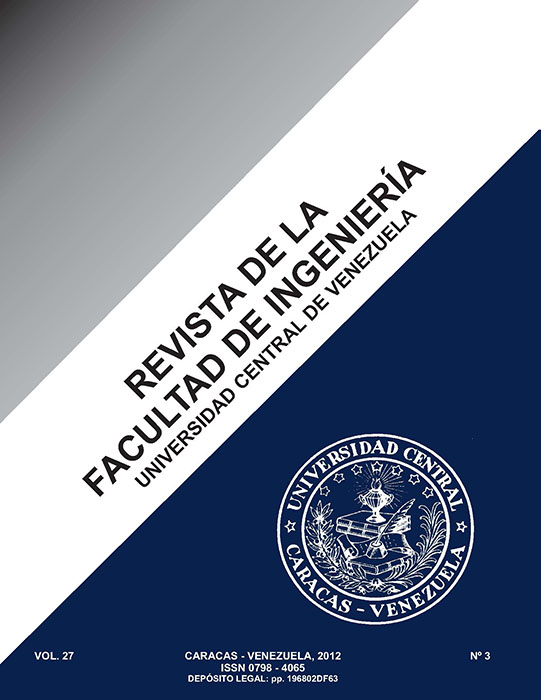ACTIVIDAD CATALÍTICA DE NANOPARTÍCULAS DE RODIO ESTABILIZADOS EN DIFERENTES LÍQUIDOS IÓNICOS EN REACCIONES DE HIDROGENACIÓN DEL CICLOHEXENO Y DEL BENCENO / Catalytic Activity of Rhodium Nanoparticles Stabilized in Different Ionic Liquids in the Hidrogenat
Palabras clave:
Nanopartículas, Rodio, Catálisis, Hidrogenación, Líquidos iónicos.Resumen
Las nanopartículas de metales de transición deben ser estabilizadas para evitar su coalescencia. En este sentido, loslíquidos iónicos (LIs) brindan la versatilidad de poder diseñar el catión orgánico, según los requerimientos de una reacciónespecífica, que puede ofrecer estabilización estérica a las nanopartículas metálicas y, por otra parte, estas sales iónicasofrecen estabilización electrostática. En este trabajo se reporta la síntesis de nanopartículas de rodio a partir del método dereducción y desplazamiento de ligando del monómero (acetilacetonato)(1,5-ciclooctadieno) de rodio (I), Rh(acac)(COD)y del dímero bis-μ-cloro-di(1,5-ciclooctadieno)dirodio(I) estabilizadas utilizando diferentes LIs del tipo hexafluorofosfatode 1-alquil-3-metil-imidazolio, [1-alquil-MIM][PF6], y hexafluorofosfato de 1-alquil-4-picolnio [1-alquil-4-PI][PF6],donde el grupo alquílico puede ser pentil o dodecil. Esto permitió determinar la influencia del precursor metálico asícomo del tamaño del líquido iónico en el tamaño y en la actividad catalítica de las nanopartículas de rodio obtenidas. Lacaracterización de dichos materiales se realizó por HRTEM, DE, DRX e ICP-OES. Todos los sistemas obtenidos estánconstituidos por nanopartículas de rodio metálico que presentan tamaños entre 1,2 y 6,4nm. El estudio del comportamientocatalítico de estos nanosistemas hacia la reacción de hidrogenación de ciclohexeno y de benceno a ciclohexano, demuestranque los sistemas obtenidos a partir del monómero son más activos que los obtenidos a partir del dímero a 25ºC. Con elsistema Rhm[1-pentil-4-PI][PF6] se obtiene una actividad de 1358 mol de producto/mol metal·h.
ABSTRACT
Transition metal nanoparticles require stabilization to prevent coalescence. In this sense, ionic liquids (IL) offer theversatility of designing the organic cation to fit the requirements of a specific reaction, rendering steric stabilization to themetallic nonoparticles. In addition these low boiling point ionic salts also provide electrostatic stabilization. This workreports the syntheses of rhodium nanoparticles using the displacement reduction method of the organometallic monomer(acetylacetonate)(1,5-cyclooctadiene)rhodium(I), Rh(acac)(COD), and the dimeric organometallic complex bis-μ-chlorodi(1,5-cyclooctadiene)dirhodium(I), [Rh(COD)Cl]2, in the presence of 1-alkyl-3-methyl-imidazolium and 1-alkyl-4-picolnium hexafluorophosphate salts, where the alkyl chains were pentyl and dodecyl. This allowed the determinationof the influence of the metallic precursor and the size of the ionic liquid in the size, distribution and catalytic activity ofthe rodium nanoparticles. The characterization of all the systems was carried out through HRTEM, ED, DRX and ICPOESanalyses. All the nanosystems obtained are made of metallic rhodium nanoparticles with sizes that vary between1.2 and 6.4nm. The comparative catalytic study towards the hydrogenation of cyclohexene and benzene show that thenanosystems obtained from the monomeric precursor are more active at room temperature than those obtained from thedimeric precursor. All systems show low activity towards the hydrogenation of benzene at room temperature, with theexception of Rhm[1-pentyl-4-PI][PF6] which exhibits an activity of 1358 mol of product/mol metal·h at this temperature.Keywords: Nanoparticles, Rhodium, Catalysis, Hidrogenation, Ionic liquids.



